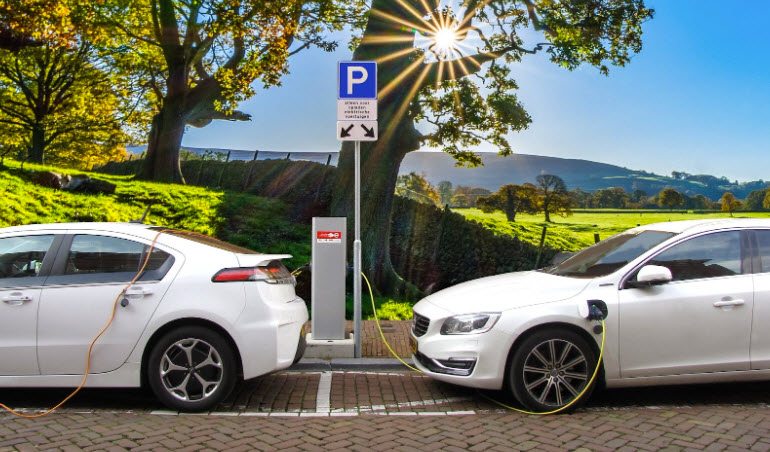Troubleshooting Common Electrical Problems in an Electric Vehicle
Whether you’re driving a luxury sports car, pickup truck, a 20-year-old sedan, or a modern electric vehicle, electrical problems can sideline your vehicle at any time. Fortunately, if you know what to look for, you can address these problems before your or your customer’s daily driver is irrevocably damaged.
As a technician or an owner, it’s beneficial to know what signs to look for when diagnosing and fixing an electrical issue that can plague one of an EV’s electrical systems. In this article, we’ll look at some electrical issues that commonly present themselves in electric vehicles.

The Basics
Before you can troubleshoot an electrical issue in an EV, it helps to have some knowledge of said vehicle’s main electrical components. Here’s a summary of the items that will come into play as you troubleshoot issues within the vehicle.
- Electric Motor – The electric motor is the nucleus of the electric vehicle. This electrical component is responsible for converting the potential energy that is stored in the battery pack (in the form of electricity), into the kinetic energy required to propel the vehicle forward.
- Battery/Battery Pack – As stated previously, the battery/battery pack is responsible for delivering the necessary kinetic energy to the electric motor, but that’s not all. The battery also powers other electronic systems – from the power windows and lighting to the dashboard mounted infotainment system.
- Onboard Charger – The onboard charger is responsible for converting the AC power that is received from a private or public charging station into the DC power that is required to charge the vehicle’s batteries.
- Various Electronics – All manner of electronic components, including converters and inverters, are used to govern the flow of electricity from the battery pack to the vehicle’s various electrical systems.
- Thermal Management System – The Thermal Management System (TMS) is responsible for ensuring the temperature of the electric motor, battery pack, and other vital components is kept within acceptable tolerances. Not only does this ensure the vehicle’s systems function optimally, but it will also prolong the life of said systems and components.
- Regenerative Braking System – Many electric vehicles leverage regenerative braking technologies to improve the range of the vehicle. These systems convert the kinetic energy that results from braking into electrical energy that can be stored in the vehicle’s battery pack.
First Steps
If any of the above systems or components (or others) have begun to malfunction or otherwise fail to perform up to spec, there are a number of steps that should be followed before you grab your toolbox. It’s worth noting at this point that only a trained technician should attempt to diagnose and service an electric vehicle.
Think of the following as the universal first steps to troubleshooting electrical issues.
First, check the vehicle for error codes. Modern EVs come with the added benefit of having a built-in diagnostics system that will provide error codes associated with the issue. Though the error codes tend to lack detail, they will provide technicians with the information necessary to begin troubleshooting. For example, an error code of “HighTemperature” may indicate that the temperature inside of the Electrical Vehicle Supply Equipment (EVSE) is too high, which is causing a decrease in the available capacity of an electric generating unit.
Next, visually inspect the charging equipment. If the vehicle is charging slower than expected, or if overnight charging has become less effective, take a few moments to visually inspect the charging cable and charging ports for any sign of damage. Additionally, you may need to inspect the charging station itself to determine if the equipment is defective.
Lastly, try resetting the system. Electric vehicles (and most modern vehicles for that matter) are more computer than method of conveyance. In some cases, you may successfully resolve an issue by resetting the vehicle’s systems or physically disconnecting and reconnecting the battery. While resetting the vehicle’s systems, take a moment to see if there are any software updates that are pending and update as required.
Battery Degradation and Performance Loss
Battery degradation is inevitable, but it can be staved off through proper maintenance and by following the charging practices recommended by the manufacturer. Mitigating battery degradation starts by regularly monitoring the health and state of the battery and by understanding what conditions expedite the process.
Battery degradation can be slowed by simply avoiding exposing the battery to extremely high or low temperatures. While it is impossible to control environmental conditions out of doors, being mindful enough to store the vehicle in a covered area or enclosed garage as conditions warrant is a good start. Likewise, maintaining a proper charge level is a relatively easy way to delay the effects of battery degradation. This means the driver should avoid completely depleting the battery and charging it to its full capacity. By keeping the battery charged in the 20% to 80% range, the life of the battery will be prolonged.
An equally common issue associated with EV batteries is loose or faulty connections. Like battery degradation, faulty connections and loose wiring can occur over time. In fact, the simple act of driving can unfasten these connections as the subsequent vibrations is enough to jostle them loose. If, upon visual inspection, you’ve identified a loose connection, simply tightening it may resolve the issue. If there are no visual indications of a loose connection, consider performing a battery reset. This can be done by locating the battery’s disconnect switch and turning it off for a few minutes. Turning it back on will reset the battery management system and may resolve the issue.
Remember that many electric vehicles come standard with a battery monitoring system. These systems allow the battery’s performance to be monitored over the life of the vehicle. Regular monitoring allows you to take proactive measures to ensure the battery performs optimally for a long time.
Unexpected Motor Shutdown
If the vehicle’s motor unexpectedly shuts down, it could be the result of a couple relatively easy-to-fix issues. Best case scenario, a motor shut down can be resolved by locating a loose or improperly connected battery cable and re-fastening it. Alternatively, this issue can be resolved by updating the vehicle’s software (if required). If these solutions do not resolve the issue, you’ll need to start checking the vehicle’s electrical system.
You might expect, EVs are driven by complicated electrical systems, including those that power the vehicle’s lights, climate controls and more. If just one of the components within a vehicle’s electrical systems has become damaged or otherwise compromised, it may cause the engine to shut down. Here are a few things that you can do:
- Check all fuses and breakers connected to the vehicle’s electrical system; if any are blown or tripped, replacing them is relatively easy and should be done without delay.
- Similar to checking the battery’s various connections, check for any loose wires or connections that may be responsible for creating a short circuit.
- Check the vehicle’s alternator and starter to ensure they are functioning as expected.
Regenerative Braking Issues
There are a couple of fairly common reasons why an EV’s regenerative braking system does not perform optimally. When troubleshooting the issue consider the following:
- If the battery is cold, the regenerative braking system will not perform as well as it would if the battery is warm. When the battery is cold the vehicle will rely on friction braking, meaning that less kinetic energy will be converted for storage in the vehicle’s battery.
- If the battery is fully charged, regenerative braking will not be engaged and that’s simply because the gathered energy cannot be stored anywhere. A visual indication may display adjacent to the vehicle’s power meter to indicate the regenerative braking system cannot be used.
Worn, old tires can hinder the performance of the regenerative braking system.
Onboard Charger Issues
Charging issues can occur almost anywhere, however, it is important to identify the causes of such issues so they can be addressed and mitigated in the future. Some of the basic points that would help in identifying the charging issue have been mentioned below.
If the charging speed is less than the maximum when charging at a public charging station, it likely means that either the battery or the charging station is cold. If temperature is not the issue the answer could be equally simple; the charging station is being subject to shared loading (i.e., charging a second vehicle at the same time). If the charger charges slowly after a software update, the update itself may be the issue. In this case, it’s possible to revert the software to an older version until the software issue is resolved.
Diagnosing and Fixing Electrical Issues
There’s a fair bit of nuance when it comes to diagnosing some of a vehicle’s electrical issues - others are much more straightforward. Regardless, as a vehicle owner or as a technician, it is important to know how these issues impact the vehicle’s performance and most importantly, how to resolve them before they become larger issues.
Though vehicles may come in all shapes, styles, and sizes, none of them are immune to common electrical issues. With that said, there will always be a need for technicians with the skills needed to keep personal and commercial vehicles running.
If you would like to learn more about servicing and maintaining EV electrical systems consider enrolling in the EV technician program at George Brown College.
Comments
Range extender unable to engage
Submitted by Paul Stanford (not verified) on Sun, 01/05/2025 - 08:51

Found that my 2024 levc taxi would come out of petrol engine mode and automatically go into full ev mode with the option to switch back unavailable.